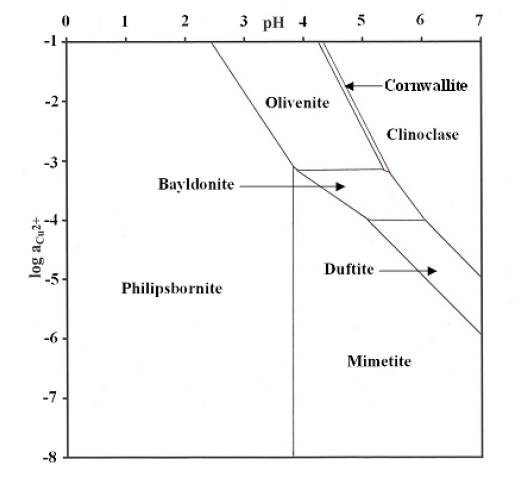At the Kintore opencut, Broken Hill South Mine, Broken Hill, Broken Hill district, Yancowinna county, New South Wales, Australia, two specimens of cornwallite have been reported. One occurs on globular conichalcite, and the other shows all the stages of replacement by globular chrysocolla (AJM 03.1.58).
At the Telfer Mine, Rudall River District, East Pilbara Shire, Western Australia, cornwallite is associated with chalcocite, chrysocolla, agardite, malachite and cornubite (AJM 12.1.36-37)
At the type locality, Wheal Carpenter, Fraddam, Gwinear-Gwithian, Cornwall, England, UK, cornwallite occurs in copper bearing sulphide veins (Mindat) associated with olivenite, cornubite, arthurite, clinoclase, chalcophyllite, strashimirite, lavendulan, tyrolite, spangolite, austinite, conichalcite, brochantite, azurite and malachite (HOM).
Cornwallite from Wheal Carpenter - Image
At Short Grain, Deer Hills, Caldbeck, Allerdale, Cumbria, England, UK, cornwallite occurs with chrysocolla and occasionally with supergene baryte in cavities in quartz or coating the exterior of blocks of altered veinstone (JRS.12.53)
At the San Rafael Mine, Quartz Mountain camp, Lodi Mining District, Lodi Hills, Nye County, Nevada, USA, cornwallite has been found with olivenite and mimetite (R&M 85.6.517).
Cornwallite from the San Rafael Mine - Image
At the Tintic Mining District, Juab County, Utah, USA, cornwallite is somewhat common throughout the copper zones in the district, but not usually found in abundance. It occurs typically as dark green botryoidal crusts. At both the Mammoth and Centennial Eureka mines it has been found as single crystals less than 1 mm in size. The better-known specimens are dark green spheres and glassy botryoidal coatings to several square centimeters on oxidised matrix of quartz or of goethite. It has been claimed that cornwallite appears to have been one of the later-formed minerals (MinRec 55.2.197).
Cornwallite from the Tintic Mining District - Image
Stability
The Activity-pH diagram below was calculated at 298.2 K for the main Cu2+ and Pb2+ arsenate minerals. Boundaries are calculated for constant activities (roughly equivalent to concentrations) of Pb2+ and Cl- ions in solution, over a range of values of pH and of Cu2+ activity. Higher chloride activites make the stability fields of bayldonite and duftite vanish, with respect to the encroachment of that of mimetite (LMW p269).

The arsenate mineral formulae are:
philipsbornite PbAl3(AsO4)(AsO3OH)(OH)6
mimetite Pb5(AsO4)3Cl
duftite PbCu(AsO4)(OH)
bayldonite Cu3PbO(AsO3OH)2(OH)2
olivenite Cu2(AsO4)(OH)
cornwallite Cu5(AsO4)2(OH)4
clinoclase Cu3(AsO4)(OH)3
Back to Minerals